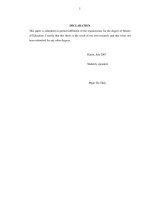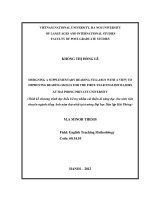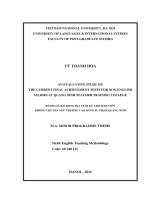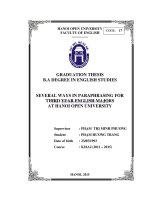A study on punctuation errors in writing of first year English majors at HPU
Bạn đang xem bản rút gọn của tài liệu. Xem và tải ngay bản đầy đủ của tài liệu tại đây (416.41 KB, 71 trang )
BỘ GIÁO DỤC VÀ ĐÀO TẠO
TRƯỜNG ĐẠI HỌC DÂN LẬP HẢI PHÒNG
------------------
KHÓA LUẬN TỐT NGHIỆP
NGÀNH NGOẠI NGỮ
HẢI PHÒNG 2010
1
HAI PHONG PRIVATE UNIVERSITY
FOREIGN LANGUAGES DEPARTMENT
----------------
GRADUATION PAPER
A STUDY ON PUNCTUATION ERRORS IN
WRITING OF FIRST YEAR ENGLISH MAJORS AT
HPU
By:
NGUYỄN CẨM VÂN
Class:
NA1004
Supervisor:
PHAN THỊ MAI HƯƠNG, B.A
HAI PHONG - JUNE 20
2
BỘ GIÁO DỤC VÀ ĐÀO TẠO
TRƯỜNG ĐẠI HỌC DÂN LẬP HẢI PHÒNG
------------------
NHIỆM VỤ ĐỀ TÀI TỐT NGHIỆP
Sinh viên : ..................................................Mã số: ...........................
Lớp : ...........................................................Ngành :..........................
Tên đề tài : ........................................................................................
.........................................................................................
3
NHIỆM VỤ ĐỀ TÀI
1. Nội dung các yêu cầu cần giải quyết trong nhiệm vụ đề tài tốt nghiệp
(về lý luận, thực tiến, các số liệu cần tính toán và các bản vẽ ).
...............................................................................................................................
...............................................................................................................................
...............................................................................................................................
...............................................................................................................................
...............................................................................................................................
...............................................................................................................................
...............................................................................................................................
2. Các số liệu cần thiết để thiết kế, tính toán.
.............................................................................................................................
.............................................................................................................................
.............................................................................................................................
.............................................................................................................................
.............................................................................................................................
.............................................................................................................................
.............................................................................................................................
3. Địa điểm thực tập.
.............................................................................................................................
.............................................................................................................................
.............................................................................................................................
.............................................................................................................................
4
CÁN BỘ HƯỚNG DẪN ĐỀ TÀI TỐT NGHIỆP
Người hướng dẫn thứ nhất
Họ và tên : .......................................................................................................
Học hàm, học vị : ............................................................................................
Cơ quan công tác : ...........................................................................................
Nội dung hướng dẫn: ......................................................................................
Người hướng dẫn thứ hai: .....................................................................
Họ và tên : .......................................................................................................
Học hàm, học vị : ............................................................................................
Cơ quan công tác : ...........................................................................................
Nội dung hướng dẫn: ......................................................................................
Đề tài tốt nghiệp được giao ngày …..tháng….. năm 2010
Yêu cầu phải hoàn thành trước ngày……tháng…..năm 2010
Đã nhận nhiệm vụ Đ.T.T.N
SINH VIÊN
Đã giao nhiêm vụ Đ.T.T.N
CÁN BỘ HƯỚNG DẪN
Hải Phòng, ngày………tháng…………năm 2010
HIỆU TRƯỞNG
GS.TS.NSƯT. Trần Hữu Nghị
5
PHẦN NHẬN XÉT TÓM TẮT CỦA CÁN BỘ HƯỚNG DẪN
1. Tinh thần, thái độ của sinh viên trong quá trình làm đề tài tốt nghiệp:
...........................................................................................................................
...........................................................................................................................
...........................................................................................................................
...........................................................................................................................
...........................................................................................................................
...........................................................................................................................
...........................................................................................................................
2. Đánh giá chất lượng Đ.T.T.N (So với nôi dung yêu cầu đã đề ra trong
nhiệm vụ Đ.T.T.N trên các mặt lý luận, thực tiễn, tính toán giá trị sử dụng,
chất lượng các bản vẽ).
.............................................................................................................................
.............................................................................................................................
.............................................................................................................................
.............................................................................................................................
.............................................................................................................................
.............................................................................................................................
.............................................................................................................................
3. Cho điểm của cán bộ hướng dẫn :
(Điểm ghi bằng số và chữ)
Hải Phòng, ngày……tháng……năm 2010
Cán bộ hướng dẫn chính
(Họ tên và chữ kí)
6
NHẬN XÉT ĐÁNH GIÁ CỦA CÁN BỘ CHẤM
PHẢN BIỆN ĐỀ TÀI TỐT NGHIỆP
1. Đánh giá chất lượng đề tài tốt nghiệp về các mặt thu thập và phân tích
số liệu ban đầu, cơ sở lý luận chọn phương án tối ưu, cách tính toán chất
lượng thuyết minh và bản vẽ, giá trị lý luận và thực tiễn đề tài.
.............................................................................................................................
.............................................................................................................................
.............................................................................................................................
.............................................................................................................................
.............................................................................................................................
.............................................................................................................................
.............................................................................................................................
.............................................................................................................................
.............................................................................................................................
.............................................................................................................................
2. Cho điểm của cán bộ phản biện:
(Điểm ghi bằng số và chữ)
Ngày …….tháng…….năm 2010
Người chấm phản biện
7
ACKNOWLEDMENT
First of all, I would like to express my deep gratitude to Mrs. Phan Thi
Mai Huong, my supervisor, for her precious guidances, comments,
corrections and most of all her kind encouragements throughout the study.
My sincere thanks are also sent to the teachers in the English Department
of Hai Phong Private University for their useful lessons and whole-hearted
advices during four years studying here.
I also would like to express my heartfelt thanks to my family whose
support has been especially important to the completion of my study.
Finally, I take this opportunity to thank my friends especially the first
year English majors at Hai Phong Private University who gave me many
precious helps and supports in collecting material for the study.
8
TABLE OF CONTENT
Part A. INTRODUCTION..................................................................................................
1. Rationale ................................................................................................... 12
2. Aims of the study. ..................................................................................... 13
3. Scope of the study. .................................................................................... 13
4. Method of study. ....................................................................................... 13
5. Design of study. ........................................................................................ 14
Part B: THE STUDY ON THE PUNCTUATION ERRORS OF FISRT YEAR
ENGLISH MAJORS ...........................................................................................................
CHAPTER 1: THEORETICAL BACKGROUND. ........................................................16
1. Academic writing..........................................................................................................16
1.1. Definition. .............................................................................................. 16
1.2. Characteristic features. .......................................................................... 16
1.2.1. Audience. ..................................................................................................................16
1.2.2. Tone ..........................................................................................................................17
1.2.3. Purpose......................................................................................................................18
2. Paragraph. .....................................................................................................................19
2.1. Definition ............................................................................................... 19
2.2. The structure of paragraph ..................................................................... 19
2.2.1. Topic sentence. .........................................................................................................20
2.2.2. Supporting sentences. ..............................................................................................20
2.2.3. Concluding sentence ................................................................................................21
2.2.4 Unity and coherence..................................................................................................21
3. Punctuation. ..................................................................................................................22
3.1. Definition ............................................................................................... 22
3.2 Role of punctuation marks in writing. ..................................................... 22
3.3. Summary of punctuation marks ............................................................. 24
CHAPTER 2: PUNCTUATION ERRORS OF FIRST YEAR ENGLISH MAJORS
AT HPU ..............................................................................................................................27
1. Types of writing taught to the first year English majors. ......................................27
9
1.1. Freewriting. ............................................................................................ 27
1.2. Paragraph writing .................................................................................. 28
2. The punctuation errors. ..............................................................................................28
2.1. Comma errors ......................................................................................... 29
2.1.1. Comma functions ..................................................................................................29
2.1.2. Comma errors. .......................................................................................................33
2.2. Colon errors............................................................................................ 38
2.2.1. Colon functions. ....................................................................................................38
2.2.2. Colon errors. .............................................................................................................38
2.3. Full stop errors. ......................................................................................... 41
2.3.1. Full stop functions ....................................................................................................41
2.3.2. Full stop errors..........................................................................................................43
2.4. Ellipsis dots errors. ................................................................................. 44
2.4.1. Ellipsis fucntions. .....................................................................................................44
2.4.2. Ellipsis dots errors. ...................................................................................................45
2.5. Question mark errors. ................................................................................ 46
2.5.1. Question mark functions. .........................................................................................46
2.5.2. Question mark errors................................................................................................47
CHATER 3: CAUSES OF ERRORS AND SUGGESTED SOLUTIONS ...................48
1.Causes of punctuation errors of first year English majors. ...................................48
2. Suggested solutions.......................................................................................................51
Part C. CONCLUSION .......................................................................................................
1.Conclusion ................................................................................................... 55
2. Suggestions for further study. ........................................................................ 55
Suggested exercises ..........................................................................................................56
Suggested keys .....................................................................................................................59
Appendix1 ..........................................................................................................................62
Appendix2 ..........................................................................................................................65
REFERENCES ...................................................................................................................70
10
Part A. INTRODUCTION
11
1. Rationale
Nowadays, a majority of countries in the world speak English which is
one of the most important languages for international communication. It
becomes a second language in all universities, in all grades. However, it is
not easy to learn a foreign language well. English majors at HaiPhong Private
University are taught four skills of listening, writing, reading and speaking
from the first term. Of the four skills, many students consider writing the most
difficult because it requires the knowledge and professional use of grammar
and vocabulary to write a paragraph as well as a complete essay. Writing is
different from spoken language. In spoken language, we use many unfinished
sentences, ungrammatical structures.
However, written language requires
formal vocabulary, correct spelling and grammar structure as well as well
organized sentences and ideas. Moreover, writing uses letters and punctuation
under rules of grammar.
Writing is used as a basic working skill and requires a hard working
process and continuous practice. A first year English major at HPU gets used
to many writing tasks such as topic- based writing paragraphs, a letter, etc.
Learners have to think clearly about what and how to write in order to have a
good writing. Punctuation marks also contribute to a complete and good
writing. Therefore, it is time to pay more attention to appropriate punctuation
marks using because good punctuations show that a student or a writer has a
good competence of using English. Besides, that helps us to express the ideas
more clearly. A student in the first year should take serious consideration into
punctuation using in writing.
However, many first year English majors
actually make punctuation mistakes, which urges me to choose a study on
punctuation errors of first year English majors at HaiPhong Private University
as my graduation paper.
12
2. Aims of the study.
The purpose of the study focus on helping the first year English majors
at HaiPhong Private University to have more specific and clear understanding
of English writing, and especially punctuations, help to find out their
punctuation errors and suggest solutions to these mistakes. That includes:
Studying on the basic theories of academic writing and
punctuations.
Finding out the mistakes of punctuation markings of first year
English major.
Finding
out
the
effective
solutions
for
frequently-made
punctuation errors.
3. Scope of the study.
Punctuation is a large aspect; however, because of limited time and
knowledge, the study only focuses on finding out the punctuation errors of
first year English majors, supplying them with the misusing of punctuation
markings, and helping them find out the effective solutions.
4. Method of study.
With the purpose of the study are to help first year English majors find
out their mistake in using punctuation marks as well as the causes for these
errors, my methods are:
Material collection through reference book study related to
English writing, grammar, and punctuations.
Quantitive and qualitive method through a survey among first
year English majors at HPU to explore their mistakes.
Data analysis
13
5. Design of study.
My study includes three parts as following:
Part A, Introduction is the introduction of my study including rationale,
aims of the study, scope of the study method of study and design of the study.
Part B, The study on punctuation errors of the first year English
majors, the main part of my study contains three chapters.
- Chapter 1: Theoretical background supplies the readers with the
theoretical background including the theory of academic writing,
paragraph, and punctuation.
- Chapter 2: Punctuation errors of first year English majors at HPU
deals with the punctuation errors of first year English majors. All the
most common errors in using punctuation marks of first year English
majors are specifically mentioned.
- The last chapter: Causes of errors and suggested solutions mentions
the causes found and the suggested solutions to avoid the mentioned
errors.
Part C, Conclusion is the conclusion and suggestions for further study.
14
Part B: THE STUDY ON THE
PUNCTUATION ERRORS OF FISRT
YEAR ENGLISH MAJORS
15
CHAPTER 1: THEORETICAL BACKGROUND.
1. Academic writing.
1.1. Definition.
―Academic writing, as the name implies, is kind of writing that you are
inquired to do in college or university.
(Oshima, 2004: 02)
1.2. Characteristic features.
Academic writing differs from other kinds of writing (personal, literary,
journalistic, business, etc) in several ways. Its differences can be explained
by its special audience, tone and purpose.
1.2.1. Audience.
Whenever you write, consider your audience, who are the people who will
read what you have written. Knowing your audience will help you reach your goal
of communication clearly and effectively. For example, one may write letters to
friends to tell them what a great time you had in school while neglecting your
studies. One may have to write an essay for a history, political science,
psychology, or English exam. Learner may have to write a letter to a prospective
employer. Each of these letters has a specific audience, and what the writer say
and how the writer say about it will affect audience‘s understanding of the
message. In academic writing, your audience is primarily your professors.
(Oshima, 2004: 02)
In order to have an interesting and valuable writing product, the writer must
decide:
Who the audience is: a classmate?, a the teacher?, a parents?, an
employer? or an admission office?
Who the writer is: a student?, a son or a daughter?, an employee or
an expert about the topic?
16
Specifying the audience is an essential step because the writer has to
make decision about topics, evidences, methods of presenting materials, and
even grammar (vocabulary, sentence structure and verb tense) according to
who will read the complete product. For most academic writing, the audience
will be the instructor who assigns the writing. Sometimes, the students write
for other audiences of the writing piece. Writers must consider the following:
What are the needs, the interests and the expectations of the
audience?
What does the audience know about the topic? What does the
reader not about the topic?
What might the readers want to know? What will engage their
interest?
1.2.2. Tone
Not only should you be concerned with your audience, but should
the tone of writing which depends on subject matter and audience. Tone
is writer‘s style or manner of expression. It reveals writer‘s attitude
towards the subject by choice of word, grammatical structures and even
by the length of the sentences. For example, a letter to a friend would
have a friendly personal tone; it would probably contain some ―slang‖
expressions and many active verb forms. A technical or scientific paper,
by contrast, would contain more passive verb forms and technical
vocabulary; it would have a highly formal, impersonal tone.
(Oshima, 2004: 02)
The tone of piece of writing is determined more by its intended
audience than by its matter subject. For example, the latest medical
research in the United State is reported in American journal of Medicine.
These scientific articles are written for very special audience of
scientists and doctors who understand medical and technical vocabulary.
However, if the same article were written for newspapers or popular
17
magazines, they would be written in general English with technical
words explained in everyday vocabulary because the intended audience,
the public, might not understand highly technical terminology. Academic
writing is always formal in tone.
(Oshima, 2004: 03)
1.2.3. Purpose
No matter what kind of writing you do, you should have a special and
clear purpose. In literary writing, the purpose is often to entertain, whereas
journalistic writing is usually seeks to inform or persuade. In academic
writing, your purpose will most be often to explain. It may also be to persuade
or to convince your audience of the correctness of your point of view on a
particular issue.
The purpose of a piece of writing will determine the rhetorical form
chosen for it. For example, an article that tries to persuade readers that nuclear
power plants are unsafe has a different purpose from an article that explains
how a nuclear plant operates. The persuasive article will be organized in one
way, and the expository article in another way.
(Oshima, 2004: 03)
There are three general purposes for writing and they can all occur in a
single essay, although usually one of the purposes is dominant:
To explain (educate, inform)
To entertain (amuse, give pleasure)
To persuade (convince, change the reader‘s mind)
18
2. Paragraph.
2.1. Definition
―A paragraph is a basic unit of organization in writing in which a group
of related sentences develop one main idea. A paragraph can be as short as a
sentence or as long as ten sentences. The number of sentences is important,
however, the paragraph should be long enough to develop the main idea
clearly.‖
(Oshima, chapter 1, 16)
A paragraph may stand by itself or may also be one part of a longer piece
of writing such as a chapter of a book or essay.
According to Dorothy E. Zemach and Lisa A. Rumiser a paragraph is a
group of sentences about a single topic. Together, the sentences of the
paragraph explained the writer‘s main idea (most important idea) about the
topic. In academic writing, a paragraph is often between five and ten
sentences long, but it can be longer or shorter, depending on the topic.
(Drothy E. Zechmach and Lisa E.Rumisek, 2003: 11)
2.2. The structure of paragraph
A paragraph has three major structural parts: a topic sentence, supporting
sentences and a concluding sentence.
Xxxxxxxxxxxxxxxx
topic sentence
xxx.Xxxxxxxxxxxxxxxxx
xxxxx.Xxxxxxxxxxxxxxx
xxxxxx.xxxxxxxx.Xxxxxx
supporting sentences
xxxxxxxxxxxxxxxx.Xxxx
xxxxxx.xxxxxxxxxxxxxxx
xxxxxxxxxxx.Xxxxxxxxx
xxxxxxxxxxxxxxxxx.Xxx
concluding sentence
xxxxxxxxxxxxxxxxxxxxx
xxxxxxxxxxxxxxxxxxxxx
xxxxxxxxx
19
2.2.1. Topic sentence.
The topic sentence states the main idea of the paragraph. It not only
names the topic of the paragraph but also limits the topic to one or two areas
what can be discussed completely in the space of a single paragraph.
(Oshima, 2004: 17)
A topic sentence usually comes at the beginning of the paragraph
(sometimes this is not true). The topic sentence introduces an overall idea that
you want to discuss later in the paragraph.
Example:
“Gold, a precious metal, is prized for two important characteristics.
First of all, it has a lustrous beauty that is resistant to corrosion.
Therefore, it is suitable for jewelry, coins, and ornamental purpose. It
never needs to be polished and will remain beautiful forever. For
example, a Macedonian coin remains as untarnished today as the day it
was minted twenty- three centuries ago. Another of its important
characteristic is its usefulness to industry and science. For many years,
it has been used in hundreds of industrial applications. Its most recent
use is astronaut’s suits. Astronauts wear heat shields made from it for
protection outside the spaceship. In conclusion, it is treasured not only
for its beauty but also for its utility.”
(Oshima , 2004:26)
In the above paragraph, the topic sentence comes at the beginning of the
paragraph. The reader can easily recognize that the topic is gold and the
controlling idea is ―two important characteristics‖. The topic sentence also
limits the topic to two areas.
2.2.2. Supporting sentences.
The supporting sentences develop the topic sentence. That is, they
explain the topic sentence by giving reasons, examples, facts, statistics and
quotations.‖
20
(Oshima , 2004:17)
2.2.3. Concluding sentence
The concluding sentence may be found as the last sentence of the
paragraph. It can finish a paragraph by repeating the main idea or just giving a
final comment about the topic.
(Dorothy E. Zemach and Lisa A. Rumiser, 2003: 12)
The concluding sentence sums up the main point or restates the main
idea in the different way. A sentence that sums up the paragraph reminds the
reader of what the writer‗s main idea and supporting points were. A sentence
that restates the main idea should give the same information in a slightly
different way,perhrps by using different words or by using different word
order. A concluding sentence should not introduce a new point.
(College writing, Dorothy E. Zemach and Lisa A. Rumiser, 2003:19)
According to Alice Oshima, the concluding sentence signals the end
of the paragraph and leaves the readers with important points to
remember. Writer can think of the concluding sentence as a sort of topic
sentence in reverse. The last sentence of the example paragraph signals
the reader the end by the transitional signal such as ―In conclusion‖. It
summarizes the preciousness of gold and the reader can remember the
two main characteristics.
2.2.4 Unity and coherence
In addition to the three structural parts of paragraph, a good paragraph
also has the elements of unity and coherence.
"Unity means that you discuss only one main idea in a paragraph. The
main idea is stated in the topic sentence, and then each and every supporting
sentence develops that idea. If, for example, you announce in your topic
sentence that you are going to discuss two important characteristics of gold,
discuss only those. Do not discuss anything else such as the price of gold, the
history of gold or gold mining.‖
21
“Coherence means that your paragraph is easy to read and understand
because your supporting sentences are some kinds of logical order and your
ideas are connected by the use of appropriate transition signals. Furthermore,
the relationship between the ideas is clearly shown by using appropriate
transition words and phrases such as ―first of all‖, ―the second important
characteristic‖, ―for example‖, and ―in conclusion‖.
(Oshima, 2004: 16)
3. Punctuation.
3.1. Definition
Punctuation is the system of symbols (. , ! - : etc) that we use to
separate sentences and parts of sentences, and to make their meaning
clear. Each symbol is called a ―punctuation mark‖.
( />According to Betty Schrampfer Azaz, in Understanding and using
English Grammar, 1999, punctuation is the standard system of symbol that is
added words and sentences to clarify their meaning.
Punctuation marks are symbols which indicate the structure and
organization of written language, as well as intonations and pauses to be
observed when reading aloud.
( />The punctuation marks separate, group, and qualify words and
elements in sentences; they help to suggest the pauses, intonations, and
gestures that would be used in speech.
―Punctuation marks are the traffic signals of language: they tell us to
slow down, notice this, take a detour, and stop‖
( />3.2 Role of punctuation marks in writing.
22
Can readers understand the meaning of the writing and the message of
the writer without punctuation? How can they read it aloud if they do not
know where they can pause, raise or down the voice? Of course, a writing
without punctuation cannot be considered as a complete writing, there is no
reliable way of communicating meaning. Therefore, the punctuation helps
you to complete your writing and communicate the meaning.
In addition, not only using punctuation marks in writing is necessary but
also the appropriate punctuations should be carefully considered. The correct
punctuation helps you to present your ideas clearly, make the meaning of your
paragraph more understandable and express your respect to the readers as
well as your good knowledge of grammatical structure.
If you use
punctuation marks incorrectly, you will make the readers confused to
understand what you mean especially in the writings which require the
exactness.
For example:
If you want to talk about the importance of woman, you can write:
Woman! Without her, man is nothing.
( />The meaning of the sentence as well as your idea will change if you use
punctuation marks differently:
Woman, without her man, is nothing.
In another situation:
Who? Are we writing to John?
Who are we writing to, John?
( />Readers can understand the meaning and purposes of these two
sentences are not the same. In the first sentence, writer wants to know
who will receive the letter and suppose that the receiver is John; while in
23
the second, writer wants to ask John who will receive the letter of John
and the writer.
For one more example: ―Do not stop!‖ means carry on, the listeners
are not required to stop. Rewriting the same words as “Don’t! Stop”
means stop whatever is being done with immediate effect. Definitely,
both the sentences would be spoken in a different manner.
In academic writing, merely expressing your ideas is not enough. The
writers also need to take care of how you express these ideas. One basic,
if easily neglected, aspect of formulating your ideas convincingly relates
to the proper use of grammar and punctuation. An abundance of
grammatical mistakes and wrong punctuation not only leave a bad
impression on the reader, they also make the process of reading more
difficult and, very often, create unintended ambiguities. As a result, your
argument becomes less convincing than you may think it is.
When writing, students usually punctuate almost by their habit,
sometimes this is acceptable, but if their habits are not formed
consciously according to accepted practices, they will have many serious
mistakes in using punctuation marks.
3.3. Summary of punctuation marks
Each punctuation symbol is called punctuation mark. Each of them
has their own using mechanics in English writing. The following is the
system of the punctuation marks commonly used in English writing:
24
Punctuation Mark
Name
Example
full stop or period
I like English.
comma
I speak English, French
and Thai.
semi-colon
I do not often go
swimming; I prefer to
play tennis.
colon
You have two choices:
finish the work today or
lose the contract.
hyphen
This is a rather out-ofdate book.
dash
In each town—London,
Paris and Rome—we
stayed in youth hostels.
question mark
Where is Shangri-La?
exclamation mark
"Help!" she cried. "I'm
drowning!"
double quotation
"I love you," she said.
marks
25









